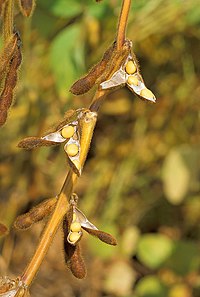
Salt adaptability in a halophytic soybean (Glycine soja) involves photosystems coordination
Sign Up to like & getrecommendations! Published in 2020 at "BMC Plant Biology"
DOI: 10.1186/s12870-020-02371-x
Abstract: Glycine soja is a halophytic soybean native to saline soil in Yellow River Delta, China. Photosystem I (PSI) performance and the interaction between photosystem II (PSII) and PSI remain unclear in Glycine soja under salt… read more here.
Keywords: soja; psi; salt; stress ... See more keywords

Genome-Wide Association Studies Reveal Novel Loci for Herbivore Resistance in Wild Soybean (Glycine soja)
Sign Up to like & getrecommendations! Published in 2022 at "International Journal of Molecular Sciences"
DOI: 10.3390/ijms23148016
Abstract: The production of soybean [Glycine max (L.) Merr.] is seriously threatened by various leaf-feeding insects, and wild soybean [Glycine soja Sieb. & Zucc.] has a greater resistance capacity and genetic diversity. In this study, a… read more here.
Keywords: soybean glycine; resistance; wild soybean; glycine soja ... See more keywords

Effect of Different Accumulative Temperate Zones in Heilongjiang on Glycine Soja Metabolites as Analyzed by Non-Target Metabolomics
Sign Up to like & getrecommendations! Published in 2023 at "Molecules"
DOI: 10.3390/molecules28083296
Abstract: To study the effect of growth temperature on the nutritional components and metabolites of the wild soybean (Glycine soja), we analyzed the nutritional components and metabolic gases of the wild soybean in six accumulated temperature… read more here.
Keywords: effect; glycine soja; temperature; analysis ... See more keywords

Comparison of Phenolic and Flavonoid Compound Profiles and Antioxidant and α-Glucosidase Inhibition Properties of Cultivated Soybean (Glycine max) and Wild Soybean (Glycine soja)
Sign Up to like & getrecommendations! Published in 2021 at "Plants"
DOI: 10.3390/plants10040813
Abstract: Wild soybean (Glycine soja Sieb.et Zucc; WS) has been used as a traditional food in China for many years and contains significantly higher levels of isoflavones than cultivated soybean (Glycine max; CS), but the secondary… read more here.
Keywords: cultivated soybean; wild soybean; soybean glycine; glycine max ... See more keywords